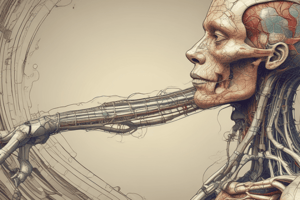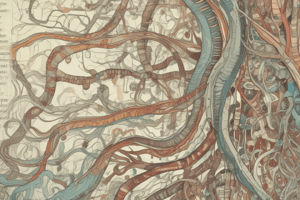Podcast
Questions and Answers
What type of cells are present in the cerebral cortex?
What type of cells are present in the cerebral cortex?
- Only nerve endings
- Only supporting cells
- Five types of cells including pyramidal cells, stellate cells, cells of Martinotti, fusiform cells, and horizontal cells of Cajal (correct)
- Only pyramidal cells
What is the outer layer of meninges around the brain and spinal cord?
What is the outer layer of meninges around the brain and spinal cord?
- Ependymal cells
- Astrocyte
- Dura mater (correct)
- Arachnoid
What type of ganglia contain the cell bodies of autonomic nerves?
What type of ganglia contain the cell bodies of autonomic nerves?
- Spinal ganglia
- Autonomic ganglia (correct)
- Cranial nerve ganglia
- Dorsal root ganglia
What is the function of dorsal root ganglia?
What is the function of dorsal root ganglia?
Where are nerve receptors mainly distributed in the body?
Where are nerve receptors mainly distributed in the body?
What is the characteristic of free nerve endings?
What is the characteristic of free nerve endings?
What type of nerve endings are found in the deeper layer of the epidermis and in the papillary layer of the dermis?
What type of nerve endings are found in the deeper layer of the epidermis and in the papillary layer of the dermis?
What is the characteristic of encapsulated nerve endings?
What is the characteristic of encapsulated nerve endings?
What type of cells are astrocyte, oligodendrocyte, microglia, and ependymal cells?
What type of cells are astrocyte, oligodendrocyte, microglia, and ependymal cells?
What is the peripheral nervous system composed of?
What is the peripheral nervous system composed of?
Flashcards are hidden until you start studying
Study Notes
Nervous System Overview
- The nervous system consists of two main parts: the Central Nervous System (CNS) and the Peripheral Nervous System (PNS)
- The CNS includes the brain and spinal cord
- The nervous system is defined by the presence of a special type of cell called the neuron, also known as a "nerve cell"
Structure of a Neuron
- Neurons are the basic functional units of nervous tissue
- They are highly specialized to transmit nerve impulses
- Nervous tissue is made up of two types of cells: neurons and neuroglia (glial cells)
- Neuroglia provide support and protection for neurons and outnumber them
Histological Components
- Supporting (non-neuronal) cells: glial cells
- Astrocytes: star-shaped cells that play an active role in brain function by influencing the activity of neurons
- Types of astrocytes: Pacinian corpuscles, Meissner's corpuscles, Ruffini corpuscles, and Krause end bulbs
Components of a Neuron
- Cell body: the expanded portion of the neuron that contains the nucleus
- Dendrites: one to many extensions of the cell body that receive input from other neurons or from receptors
- Axon: a neuron process that projects to and synapses with dendrites or cell bodies of other neurons or with non-neuronal targets
Types of Neurons
- Anaxonic neurons: no distinct axon or dendrites; found in the brain and special sense organs
- Bipolar neurons: one dendrite and one axon; found in special sense organs and relay from receptors to neurons
- Unipolar neurons: one long axon and dendrites at one end; found in most sensory neurons
- Multipolar neurons: two or more dendrites and one long axon; found in most CNS neurons
Functions of Neurons
- Motor (Efferent): related to innervation of muscle, glands, etc.; activation of these neurons leads to some motor event
- Sensory (Afferent): related to the transfer of sensory information; e.g., neurons of spinal (dorsal root) ganglia
- Interneurons: neither motor nor sensory; e.g., neurons responsible for the various spinal reflexes
Axons
- Morphologically, axons are divided into two types: myelinated and non-myelinated
- Myelinated axons: invested with a membranous, lipid sheath; allow for increased speed of conduction along an axon
- Nodes of Ranvier: breaks in the continuity of the myelin sheath; occur regularly in both the peripheral and central nervous systems
Neuroglia of the PNS
- Schwann cells: provide myelination to axons in the PNS and have phagocytotic activity
- Satellite cells: surround neurons in sensory, sympathetic, and parasympathetic ganglia, helping to regulate the external chemical environment
The Central Nervous System
- Principal structures: cerebrum, cerebellum, and spinal cord
- The cerebral cortex contains five types of cells: pyramidal cells, stellate cells, cells of Martinotti, fusiform cells, and horizontal cells of Cajal
Meninges
- Three layers of meninges around the brain and spinal cord: dura mater, arachnoid, and pia mater
Peripheral Nervous System
- Consists of peripheral nerves, ganglia, and nerve endings
- Three types of ganglia: dorsal root ganglia, cranial nerve ganglia, and autonomic ganglia
Nerve Endings (Receptors)
- Distributed throughout the body, mainly in the skin
- Two types of nerve endings: free nerve endings and encapsulated nerve endings
Studying That Suits You
Use AI to generate personalized quizzes and flashcards to suit your learning preferences.




